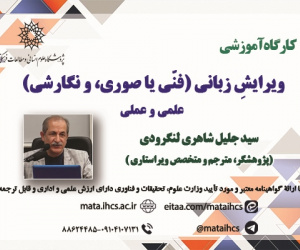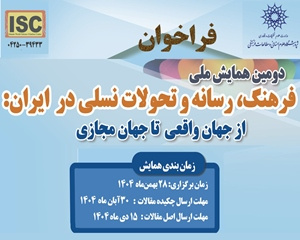عوامل تسهیل گر و بازدارنده ی مشارکت روستاییان در پروژه ی بین المللی ترسیب کربن (CSP) (مطالعه ی موردی، پروژه ی گل چشمه، شهرستان محلات، استان مرکزی) (مقاله علمی وزارت علوم)
درجه علمی: نشریه علمی (وزارت علوم)
آرشیو
چکیده
کاهش آسیب های زیست محیطی و جلوگیری از تخریب اراضی و کاهش تنوع زیستی، طی سال های اخیر، به یکی از دغدغه های اصلی سیاست گذاران کشاورزی و حفظ محیط زیست تبدیل شده است. در این میان، برنامه های پرداخت بهای خدمات اکوسیستم(PES)- در این پژوهش، پروژه ی بین المللی ترسیب کربن(CSP < /span>) - با ارائه ی مشوق های مالی برای تغییر ساختار و به کارگیری شیوه هایی که کم تر به محیط زیست آسیب وارد می سازند، از مشارکت جوامع محلی برای کمک به دولت در مدیریت محیط زیست بهره می برد. در مقاله ی حاضر به بررسی تجربیات اجرای برنامه های پرداخت بهای خدمات اکوسیستم در یک محیط نهادی ضعیف و تأثیر آن بر چگونگی مشارکت بهره برداران روستایی(دامداران) در منطقه ی گل چشمه از توابع شهرستان محلات پرداخته شده است. ایﻦ ﭘﮋوﻫﺶ، ﺑﻪ ﺻﻮرت ﮐﯿﻔﯽ و ﺑﻪ روش مطالعه ی موردی اﻧﺠﺎم گرفته است. گردآوری اطلاعات از طریق مصاحبه های نیمه ساخت یافته و عمیق از 43 نفر از بهره برداران روستایی استخراج شده است. تحلیل و کدگذاری تفسیری یافته های حاصل از مصاحبه ها منجر به پیدایش 4 مضمون اصلی تحت عنوان نحوه ی پرداخت تسهیلات: منبع/ هدف، اشتراک گذاری هزینه ها/ توزیع عادلانه منابع/ جبران هزینه ها و دست یابی به سود منطقی، مشاوران محلی/ حمایت مداوم و مستمر و ساختار جمعی فعالیت/ ارتباطات و شبکه های اقتصادی و اجتماعی شد که در میزان مشارکت بهره برداران محلی تأثیرگذار بودند. به طور خلاصه می توان گفت پروژه ی ترسیب کربن با دو ضعف اساسی مواجه است: 1) ناکارآمدی ترتیبات نهادی: بسیاری از سازوکارهای مدیریتی تنظیم شده با واقعیت های موجود در منطقه و علایق مردم محلی هماهنگی ندارد و مانع از استفاده ی پایدار از منابع آب وخاک و نیز شکل گیری کارهای جمعی(واقعی) می شود؛ 2) افزایش بازدهی و سودآوری صندوق های محلی: بهره برداران به دلیل ناچیز بودن پرداخت ها قادر به استفاده از تجهیزات و نهاده های جدید برای گذار و ارتقای اشتغال های جایگزین و درنهایت تبدیل و بالا بردن ارزش افزوده ی محصولات تولیدی نیستند، لذا در این وضعیت روی به محافظه کاری آورده اند و ریسک نمی کنند.Factors Facilitating and Inhibiting the Participation of Rural People in International Carbon Sequestration Project (CSP) (Case Study: Galcheshme Project, Mahallat County, Markazi Province)
Introduction
Reducing environmental damage and preventing land degradation and reducing biodiversity has become a major concern for agricultural policy makers and preservation of environments in recent years. Many scholars in developing countries, including Iran, have the most important reasons for the government's failure to stabilize the environment in terms of control and command and control (standards, bans, permits and quotas), lack of attention to the ability of villagers in economic discussion and ignoring the rural population's ability for working the infrastructure. They believe that at present, the AES, which is listed below under the Ecosystem Services Payment Scheme (PES), is in the study of the carbon sequestration project (CSP) It will help improve the economic situation and livelihoods of villagers and small producers, since they will be able to improve the level of production and agricultural productivity and existing livestock by taking advantage of financial support and concessional facilities and so they are less likely to get more land and overgrazing, and in general, the destruction of natural resources and the environment. In recent years, some developing countries have shown the power and participation of local communities to help the government manage and protect their financial and credit incentives to rebuild and apply less environmentally-friendly practices.
In this article, we examine the experience of implementation of ecosystem service payment plans in a weak institutional environment and its impact on how rural farmers participate in Galcheshme area of Mahallat County. Where the spread of such schemes involves many problems, such as uncertain rights to uncertain ownership of enterprises, lack of markets and supply and demand systems, weak technical and educational infrastructure, the lack of a strong private body, low risk of exploitation, and the state's inability to supply capital and financial resources to advance goals. Most importantly, land and natural resources are in the ownership and management of the state, and the right to exploit resources is given to influential and powerful people, and often in industrial and destructive activities (mining and mining operations), organizations relating to natural resources and the environment at the regional and local level as it should not be supported, The general attitude of the local people towards the state plans has a significant negative orientation. However, various organizations involved in the implementation of agro-environmental programs and the payment of ecosystem services, and rules and guidelines have been designed and registered in this area and activities have been carried out in different areas to get the attention of the views of local users. In order to develop standards for identifying and assessing institutional factors that affect the involvement of local utilities and poor households in the payment of ecosystem services (PES), the concept framework of Mettepenningenet al. (2013) has been used. These factors include behavior and belief norms about environmental responsibility, existing participation and past experience, and the attitude towards organization management and the level of trust in established organizations. In this study, the perceptions and views of local authorities on the design, actions and partnerships and the risks and potential benefits of it have been investigated.
Materials and Methods
The research method in this study is a case study and qualitative analysis of data which is used through direct observation through semi-structured and in-depth interviews. This strategy allows us to describe and reveal our complex social relationships and relationships between actors and activisms. According to Breweret al. (2002), the selection of 20 to 30 participants is usually sufficient to identify a coherent set of cases in a qualitative way, as was done in this study. A targeted sampling of 30 people was invited for the interview. The data analysis was performed in three stages of open, axial and selective coding using the MAXQDA software to determine the main indicators.
Discussion and Results
The number of 347 initial codes derived from the interviewer and observations of the researcher in response to questions related to the factors affecting the participation of rural people in carbon sequestration project, indicates a set of facilitator (84) and inhibitor (263) within the framework of the Mettepenningen institutional Model. The codes were classified according to common characteristics, and the result of this classification was 16 sub categories, which, in turn, were based on the common themes in the four main categories of facility payment: source / purpose, cost sharing / fair distribution of resources / cost compensation and achievement of logical profit, local advisers / continuous support, and ultimately the collective structure of activities / communications and social and economic networks. These factors, in nature, would have made it easier or more difficult for the villagers to participate. In summary, it can be said that the carbon sequestration project has two basic weaknesses: (1) inefficiency of institutional arrangements: many management mechanisms adjusted to the realities of the region and the interests of the local population do not match the sustainable use of resources water and soil, as well as the formation of collective labor (real); (2) increasing the efficiency and profitability of local funds; because of insignificant payments, the utilizers are able to use new equipment and inputs for the transition and promoting alternative employment, and ultimately increasing and increasing the value of productive products, so in this situation, They go on to conservatism and do not risk.
Conclusions
In one conclusion, any environmental interventions, such as carbon sequestration project, will be challenging and problematic in weak institutional arrangements. But it should not be forgotten that the payments made in this project and through local microfinance funds reduced to a certain extent the problems of administrative and banking regulations and the high interest rates on facilities and delinquent installments, in other words, the local people have, albeit insignificantly, been given financial resources, which can further contribute to the financial consolidation of the established institutions. On the other hand, government agencies and organizations have been spending the least amount of money on environmental protection and pasture conservation as part of the carbon sequestration project and public participation, while preserving many species of rangeland and native plants are strengthened. However, the implementation of the carbon sequestration project has not been successful in establishing local management and the importance of maintaining pasture in the public. But local management mechanisms will become more sustainable, and local people will need to maintain the rangeland and the environment in their own right. This cannot be achieved except by considering local conditions for creating management arrangements and incorporating cultural and social incentives.








